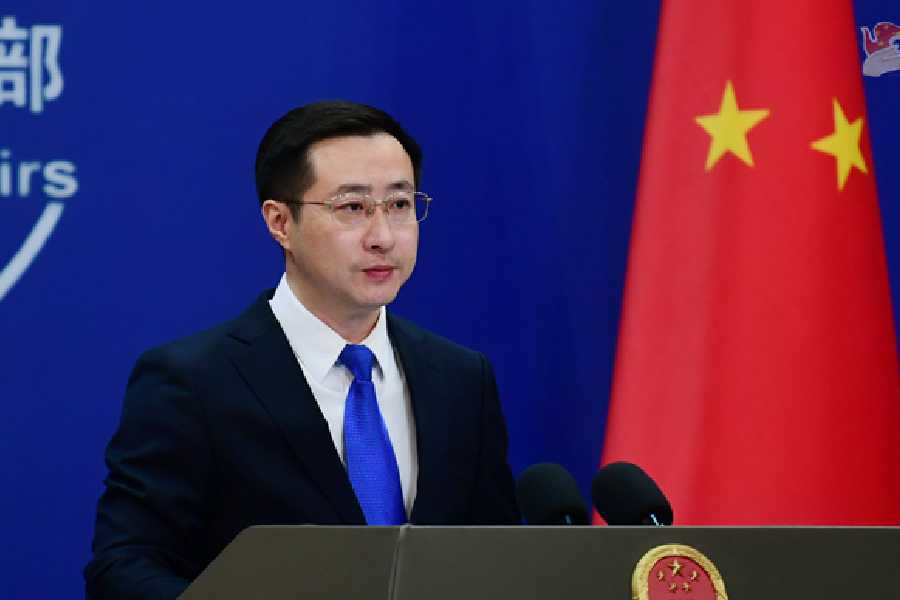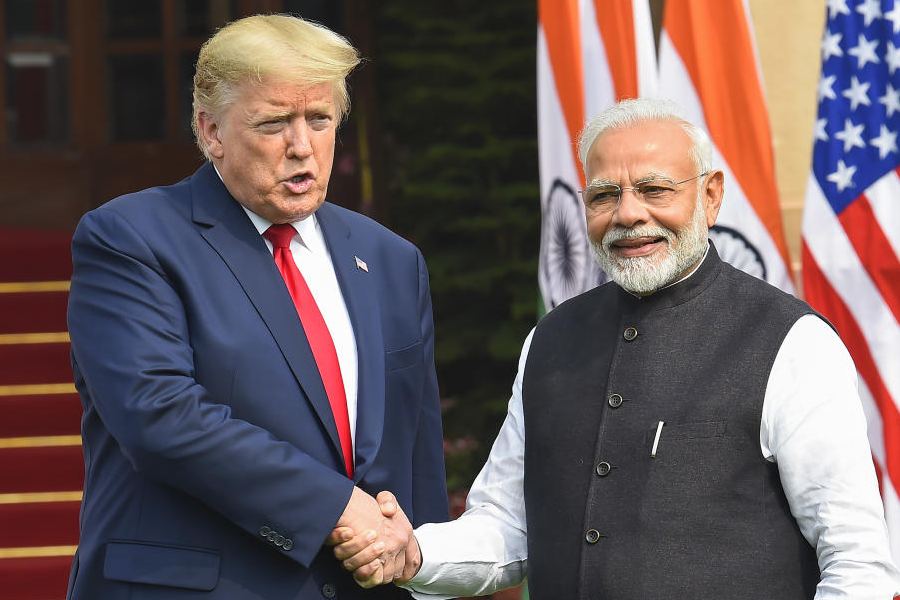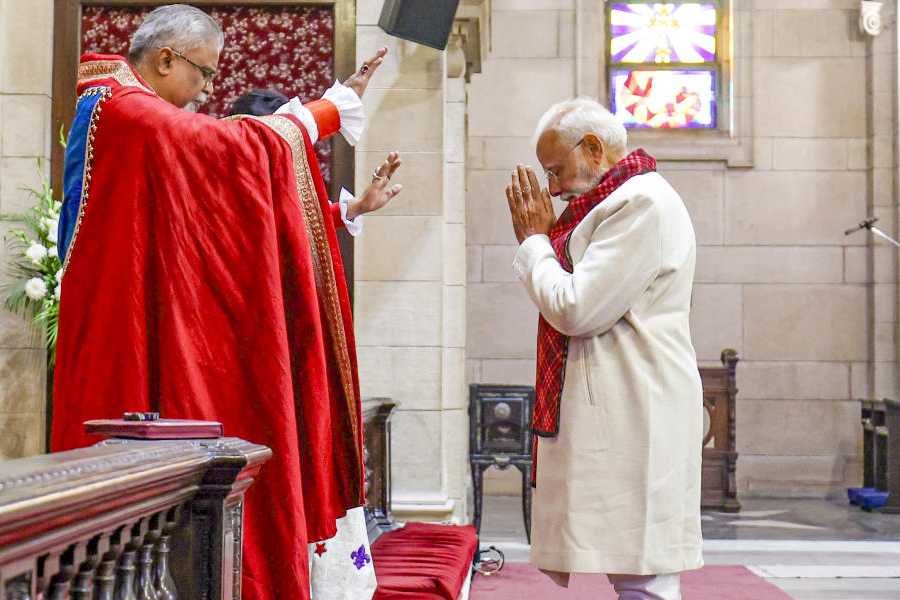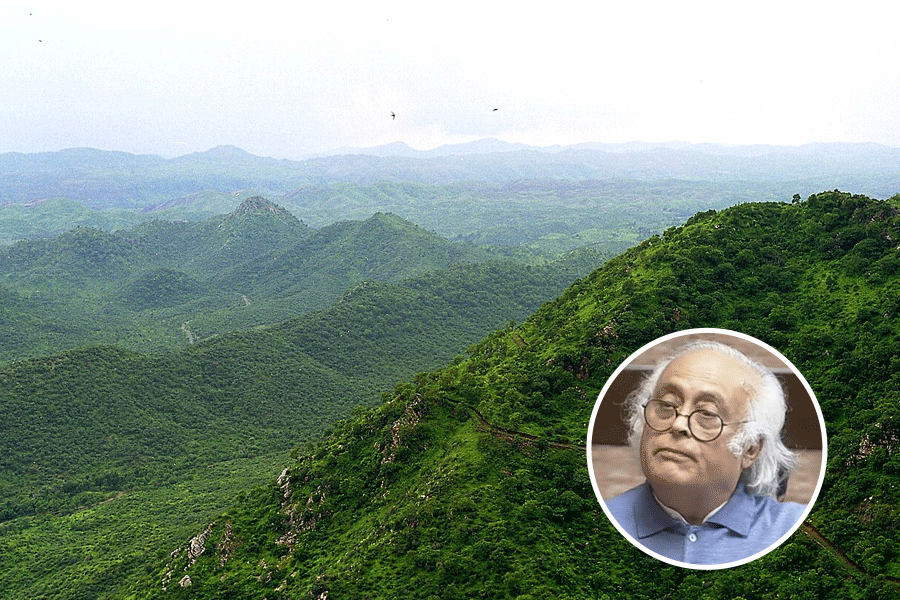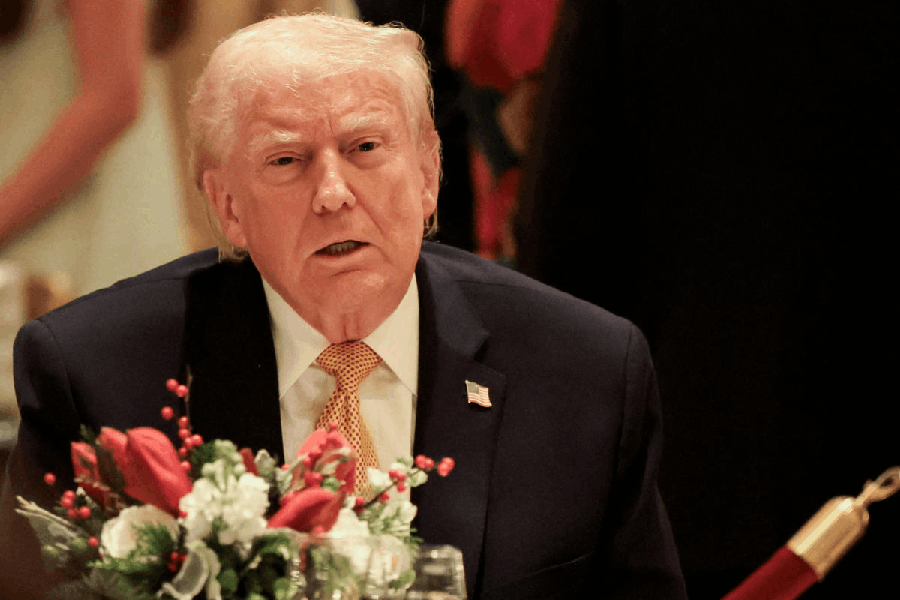 |
| Narendra Modi and Xi Jinping during the signing of agreements at Hyderabad House on Thursday. Picture by Rajesh Kumar |
New Delhi, Sept. 18: India and China have yanked negotiations over their festering boundary dispute from the outhouse to the front lawn of their diplomatic agenda after 26 years, breaking away from an unspoken agreement their former leaders had struck after a historic handshake in 1988.
Prime Minister Narendra Modi and Chinese President Xi Jinping both independently said today that they would strive for an “early” resolution of the six-decade-old differences that are at the root of the current standoff in Ladakh.
Xi and Premier Li Keqiang, who took over China’s reins in late 2012, had in their 2013 meetings with Manmohan Singh indicated a desire to speed up boundary talks.
But no Chinese President or Indian Prime Minister had over the past two decades declared an intent to make the border solution the centrepiece of their bilateral agenda as emphatically as Xi and Modi did today.
“China is determined to settle the border dispute with India amicably, at an early date,” Xi said this afternoon minutes after speaking with Modi for close to two hours. “We have the sincerity to work on this issue.”
Xi repeated his desire to push for an “early” resolution at an address he delivered at a think-tank in the evening.
Modi used similar words in a public statement after meeting Xi in the capital a day after hosting the Chinese President in Ahmedabad.
“I raised our serious concern over the repeated incidents along the border,” Modi said. “We should seek an early resolution of the boundary question.”
The Prime Minister also asked Xi to end the freeze in talks on a sub-dispute that feeds into occasional tension along the Line of Actual Control (LAC), the de-facto border between the nations on whose definition the two countries differ.
India’s version of the line lies north of the one the Chinese accept, effectively creating a strip of land that both insist belongs to them and where any intrusion by either side sparks tension.
“I also suggested that clarification of the Line of Actual Control would greatly contribute to our efforts to maintain peace and tranquillity and requested President Xi to resume the stalled process of clarifying the LAC,” Modi said.
India and China had begun exchanging maps to try and identify a mutually acceptable line, but Beijing pulled out of the process in 2008 questioning the authenticity of India’s maps.
Xi did not respond to Modi’s specific request to renew the negotiations on demarcating the colonial-era line but both sides know that no resolution to the border dispute is even theoretically possible without an agreement on the LAC first.
The new focus on an “early” solution represents recognition by the two nations of a global reality very different from 1988, when Rajiv Gandhi and Chinese leader Deng Xiaoping had decided to leave their boundary dispute for future generations to resolve.
“Future generations will be wiser and better accomplished to solve these problems,” Deng had famously said to describe his foreign policy approach on contentious neighbourly relations – not just with India, but also with Taiwan, which China claims.
That decision by Rajiv and Deng to end the paranoid, post-1962 war, focus on the border differences was rooted in the economic reforms the Chinese leader had unleashed in 1979 and those the Indian Prime Minister was contemplating.
India’s 1991 reforms strengthened the mutual stake both nations held in ensuring a peaceful border that allowed them to focus on their domestic economic growth, unfettered by major bilateral tensions.
But officials from both nations have in recent weeks increasingly admitted that neither India nor China can allow the 1988 agreement to fester much longer.
For India, the alleged incursions by Chinese troops in Ladakh and Beijing’s decision to issue stapled visas to Indian nationals from Arunachal Pradesh represent domestic political bombs that leave the government defensive.
For China, the urgency is possibly even greater. Surrounded by increasingly hostile neighbours, barring North Korea, and a tense Asia-Pacific region, China is today seeking not just an economic relationship with India but a closer strategic partnership.
“We want to strengthen our strategic relationship with India,” Xi said today. “That will help Asia and the region, but also the world.”
Today, baby steps were taken towards building that strategic partnership.
Several of the announcements and commitments the two sides made were, on the face of it, either economic or involving people-to-people contacts.
Indian pilgrims will now be able to travel to Lake Manasarovar and Mount Kailash in Tibet through the Nathu La pass in Sikkim, in addition to the existing route that starts in Uttarakhand.
China will send hundreds of teachers to train Indian lecturers in Mandarin so they can, in turn, teach the language in Indian schools and colleges. India will fete China at the Goa international film festival and at the Delhi book fair, and the two countries will collaborate in making movies.
Beijing will upgrade the speed of Indian trains and sell high-speed trains to New Delhi. It will set up two industrial parks, one in Gujarat and the other in Maharashtra. And it will invest $20bn in India over the next five years.
But unannounced, China and India quietly also smuggled in agreements that represent a growing strategic element to their relationship and point to Xi’s proclaimed aim.
Modi and Xi decided that China and India would later this year hold their first ever “maritime cooperation dialogue” to discuss their positions on maritime security and the freedom of navigation.
The talks are significant because Japan, Vietnam and the Philippines have accused China of threatening their ships’ freedom of navigation in the South and East China Seas, and have been desperately seeking India’s support.
The two leaders also agreed to begin discussions on civil nuclear cooperation. China, as The Telegraph had reported on September 11, is keen to sell India nuclear reactors. India has been non-committal but hasn’t rejected the offer.
But China knows it cannot build any true strategic partnership with India if the two nations continue to distrust each other over their boundary spat.
India and China had in 2003, when Atal Bihari Vajpayee was Prime Minister, set up a mechanism under “special representatives” appointed by each nation to draft a blueprint for a resolution and then to work towards it.
The representatives from the two nations have drawn up a blueprint, and last year piloted a border defence cooperation agreement to help resolve instances of tension along the LAC quickly.
Tensions have, however, erupted repeatedly along the border over the past two years, a reminder that the steady but slow progress made by the special representatives needs speeding up. India is in the process of finalising a new representative to succeed former national security adviser Shivshankar Menon.
A year back, then foreign minister Salman Khurshid had described alleged intrusions by Chinese troops into Indian-claimed territory as mere “acne that erupts on an otherwise beautiful face”.
Modi and Xi today suggested that the acne might now receive stronger treatment.
what the two sides agreed on
Key takeaways from Xi’s talks with Modi
• Boundary dispute jumps to the top of the India-China agenda after 25 years
• China promises $20bn investments in five years
• Nuclear cooperation to begin — China has offered India reactors
• First India-China maritime co-operation dialogue later this year — significant because Japan, Vietnam and other East Asian nations have tried to get India to criticise what they claim is Chinese aggression in the South and East China Seas
• China agrees to open up new pilgrimage route to the Manasarovar Lake and Mount Kailash through Nathu La in Sikkim
• Agreement under which China will sell India high-speed trains and accompanying infrastructure — a trial run will be carried out for the Chennai-Mysore route
• China to set up two industrial parks in India — in Gujarat and Maharashtra
• China to send hundreds of language teachers to train faculty in India to teach Chinese in schools and colleges here
• China to bestow “friendship” award on Visva-Bharati and two other universities
• Pacts for enhanced cooperation in film-making and book publishing
• Sister city agreements between Mumbai and Shanghai, and between Ahmedabad and Guangzhou


